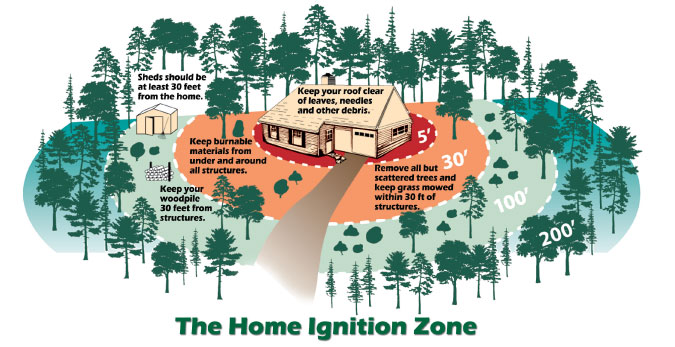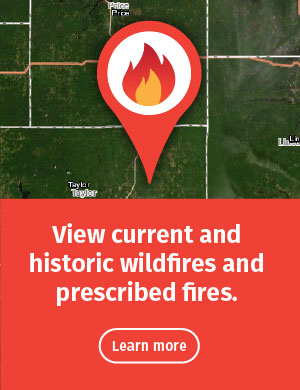Preparing Your Property
A unique wildfire danger is growing where homes and other buildings are built in areas of highly flammable vegetation, creating a condition called the wildland urban interface. Homes and cabins in the middle of forests, housing developments on the edge of pine plantations, lake communities surrounded by oak and pine forests or even homes next to grasslands all exemplify this condition. Buildings on sandy soils with an abundance of pine, oak and grass are especially concerning. Having undeveloped woodlands and fields in and around a neighborhood indicates that you, as the property owner, should prepare your home for wildfire [PDF].
At-risk homes
Think about your home or vacation property as you go through this checklist. The more items you check, the more likely you have a property at risk to wildfire and should take action to become "Firewise."
- I own a home in a rural area.
- My home is in a wooded area.
- Outside I see tall grass, oaks or pine trees.
- Outside, I see more pine needles and leaves than lawn.
- The soil around my property is sandy.
- Burning takes place on my property or my neighbor's property (campfires, leaf or brush burning, burn barrel use).
- I, or my neighbor, dump wood ash outdoors.
- I have heard about wildfires having occurred in the area.
- There is a Smokey Bear fire danger sign in my community.
Home ignition zone
The home ignition zone [PDF] is your home and its surroundings out to 100–200 feet. Research has shown that the characteristics of buildings and their immediate surroundings determine the risk of ignition—that's why preparing your home ignition zone is so important.
Since you, as the homeowner, are the only one who has authority to make changes around your home, you play a vital role in protecting it. The steps you take to reduce or change the fuels in your home ignition zone could determine whether or not your home survives a wildfire.
- Home Ignition Zone Self-Assessment for Homeowners [PDF]
- Firewise Landscaping Guide [PDF]
- Proper Tree Pruning [PDF]
- Home Composting [PDF]
Waterfront property
Many waterfront homes and cabins in Wisconsin are in areas prone to wildfires. Making your waterfront property Firewise does not mean having to sacrifice your shoreline stability, water quality or wildlife habitat. Oftentimes, the greatest wildfire protection you can offer your home is by removing "the little things" that can ignite, such as the leaves, pine needles and other debris that collects on your roof, in your rain gutters, next to your foundation or under your deck. The same places where this fallen debris gathers are the same places where flying embers will gather during a wildfire.
Remember that Firewise recommendations are just that—recommendations. They do not surpass covenants, ordinances, regulations or laws, including shoreland regulations. Wherever you own property, you should be aware of all applicable local, state and federal restrictions towards vegetation management.
Download our brochure "Protect Your Waterfront Home from Wildland Fire" [PDF] to learn more.
Driveway access
If there's a wildfire in the area, firefighters may need to reach your home. If firefighters cannot safely drive a fire truck to your house, they will have to come up with another plan. Perhaps they will park on the street and run hoselines down your driveway to your house or maybe they will send in a smaller truck to assess the situation. They will try to come up with a way to get to your home but it will likely take longer. As you can imagine, the faster a fire is extinguished the lower the risk of damage.
Doing your part
As the homeowner, you are the first line of defense when it comes to helping your home survive a wildfire. When you do your part to ensure adequate driveway access, it means that:
- you have a safe route to leave your property when evacuation is necessary;
- firefighters can locate your home and reach it quickly; and
- firefighters have a safe place to work around your home.
Download our driveway access flyer [PDF] to get tips on how you can help firefighters protect your home during a wildfire.
View our driveway access video [VIDEO exit DNR] for additional tips and information.
Building materials
When building a home or updating an existing one, simple adjustments to your design can greatly improve its ability to survive a wildfire. Check out our building materials brochure [PDF] to learn more about ignition-resistant building materials and construction techniques.
Roof, soffits and eaves
The roof can be a vulnerable part of your home because it provides a large horizontal surface where embers can land and ignite combustible materials. It is very important that roofing materials be fire-resistant and debris is removed from roof valleys, rain gutters and locations where the roof intersects a wall. Prune tree branches within 10 feet of your roof.
Eaves (the projecting roof edges), fascia, soffits and rain gutters are susceptible to flying embers and flame exposure. They should be constructed of non-combustible materials. Eaves should be boxed-in to prevent flying embers from entering.
Exterior walls and vents
Non-combustible siding materials such as brick, stucco and fiber-cement resist fire much better than wood. The exception is heavy timber or log wall construction as it takes a long time for large timbers to ignite and burn. Vinyl siding can melt, fall off and burn when exposed to flames and radiant heat, which can leave openings and make the home even more vulnerable to radiant heat, flames and flying embers.
Attic and under-eave vents that are unscreened can draw embers into the attic, igniting the structure from the inside. All vent openings should be covered with 1/4 inch corrosion-resistant wire mesh. Plastic and nylon mesh are not appropriate options as they can easily melt.
Windows
Radiant heat from burning vegetation or a nearby structure can cause the glass in windows to break. This will allow embers to enter and start internal fires. Single-pane and large picture windows are particularly vulnerable to glass breakage. Install dual-pane windows with a minimum of one pane being tempered glass to reduce the chance of breakage during a fire.
Garage doors
Install weather stripping around and under the vehicle access door to reduce the intrusion of embers. If the garage is attached to the home, install a solid door with self-closing hinges between living areas and garage.
Lesson learned
On May 14, 2013 a single spark from a logging operation in Douglas County ignited a wildfire that consumed 7,442 acres. Named the Germann Road Fire due to its location, the fire burned more than 100 buildings, including 23 homes and seasonal cabins. Another 350 buildings were in harm's way, yet ultimately survived or were saved by fire suppression efforts. A research project conducted shortly after the fire provided us with an opportunity to share information with property owners on how to prepare their home and property for a wildfire.
How to prepare for embers
Defensible space is the area 30 feet around buildings that is maintained to limit the amount of flammable vegetation, debris and man-made objects that can become 'fuel' for a wildfire. You can prepare for embers with a few simple steps:
- Rake leaves away from the side of your house and from under your deck.
- Remove leaves and pine needles from your roof and gutters.
- Remove flammable items (like wood mulch) from the five-foot zone nearest your home.
- Move firewood at least 30 feet away from your home.


